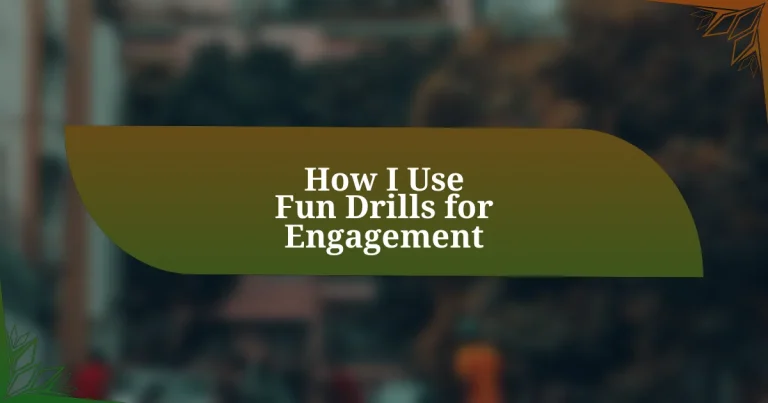Key takeaways:
- Cricket fosters teamwork and builds character in kids through engaging and fun activities.
- Effective engagement enhances skill retention, patience, and friendships among young players.
- Implementing playful drills and celebrating successes creates a nurturing environment that inspires participation.
- Measuring engagement through observation, feedback, and skill improvement is essential for tracking progress.
Introduction to cricket for kids
Cricket is not just a game; it’s an exciting adventure for kids that fosters teamwork and builds character. I remember my first day on the cricket field, feeling a mix of excitement and nerves. Can you recall that moment when you discovered a sport you loved? It’s those first experiences that ignite a passion for the game and encourage children to keep coming back for more.
Engaging kids in cricket starts with making it fun and approachable. When I coach young players, I focus on introducing them to the basics through playful drills that capture their imagination. Have you seen children light up when they accomplish their first successful batting swing? It’s those small victories that not only boost their confidence but also foster a lasting love for the sport.
Understanding the fundamentals of cricket is essential for young learners. Each skill—from bowling and batting to fielding—can be broken down into manageable, enjoyable tasks. I’ve found that when kids grasp the basics while having fun, they develop a strong foundation for their future in cricket. What’s more rewarding than seeing a child’s eyes widen with joy when they make a great catch? It’s moments like these that underscore the importance of making cricket accessible and engaging for the youngest players.
Importance of engagement in cricket
Engagement is crucial in cricket, especially for kids, as it transforms learning into an enjoyable experience. I recall a session where I introduced a “mini-match” format, and the kids thrived on the excitement of competition. Have you ever witnessed the enthusiasm in a child’s face during a friendly game? That spark not only enhances their skills but also cements their love for cricket.
When kids feel engaged, they are more likely to participate actively, leading to better skill retention. I remember teaching bowling techniques to a group of beginners; it was fascinating to see how quickly they picked up the motions when we added a fun challenge. Don’t you think that making drills competitive creates a stimulating environment where kids strive to improve and support each other?
Building engagement isn’t just about fun, either. I’ve seen that when kids are involved, they develop better patience and focus. For instance, I once had a shy child who blossomed during team activities, finding camaraderie with peers through laughter and shared goals. Isn’t it incredible how engagement in cricket can shape not just skills but also friendships and a sense of belonging?
How to implement fun drills
To implement fun drills effectively, I recommend starting with simple icebreakers that spark laughter and camaraderie among the kids. For instance, I once used a game where students had to catch a ball thrown by their teammates while balancing on one leg. The giggles erupted, and I could see how the playful challenge not only improved their catching skills but also bonded them. Don’t you think that shared laughter enhances teamwork?
Next, I like to mix basic skills with elements of surprise to keep kids on their toes. One memorable drill involved creating a series of stations, each with a distinct challenge—like bowling at targets hidden under colorful cones. It transformed an ordinary practice into an exhilarating obstacle course. How fantastic is it to see kids eagerly move from one station to the next, cheering for each other?
Lastly, reflecting on the achievements during these fun drills can amplify the excitement. I often share snippets of impressive performances or funny moments at the end of each session. After one drill, I showcased a video compilation of their best moments. The smiles on their faces were priceless! Wouldn’t you agree that celebrating both success and effort creates a nurturing environment where kids feel valued and inspired to participate more?
Tips for measuring engagement success
To effectively measure engagement success, I believe in observing participation levels during drills. For instance, I once noted that when I introduced a fun drill involving music, the kids were not only more active but also more enthusiastic. Their laughter and chatter during the activity indicated a higher level of engagement. Have you noticed how music can instantly uplift the mood and prompt kids to get involved?
Another strategy I employ involves gathering feedback directly from the kids. After a session, I like to ask them what they enjoyed and what they’d like to try next. I vividly remember a day when a shy player surprised me by sharing a new game idea that everyone resonated with. It was a reminder that their voices matter. Isn’t it empowering to see kids take ownership of their learning experiences?
Lastly, I often track skill improvement over time, which also reflects engagement. After every few weeks, I like to evaluate their progress with simple assessments, observing both their technique and enthusiasm. In a recent session, one child who had struggled initially beamed with pride after nailing a tricky skill. It’s evidence that when kids are engaged, they not only enjoy themselves but also grow. Don’t you think celebrating these milestones can strengthen their confidence?



